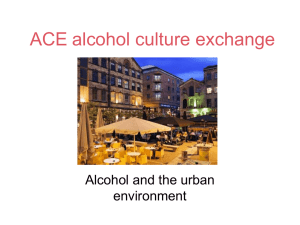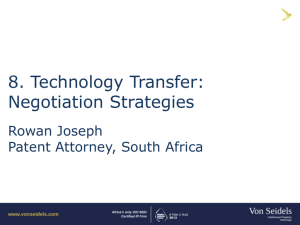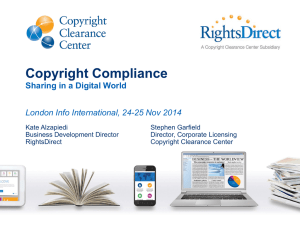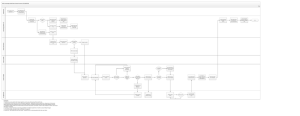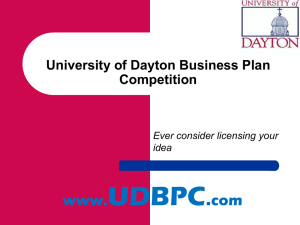Agenda Licensing: As A Market Entry
advertisement
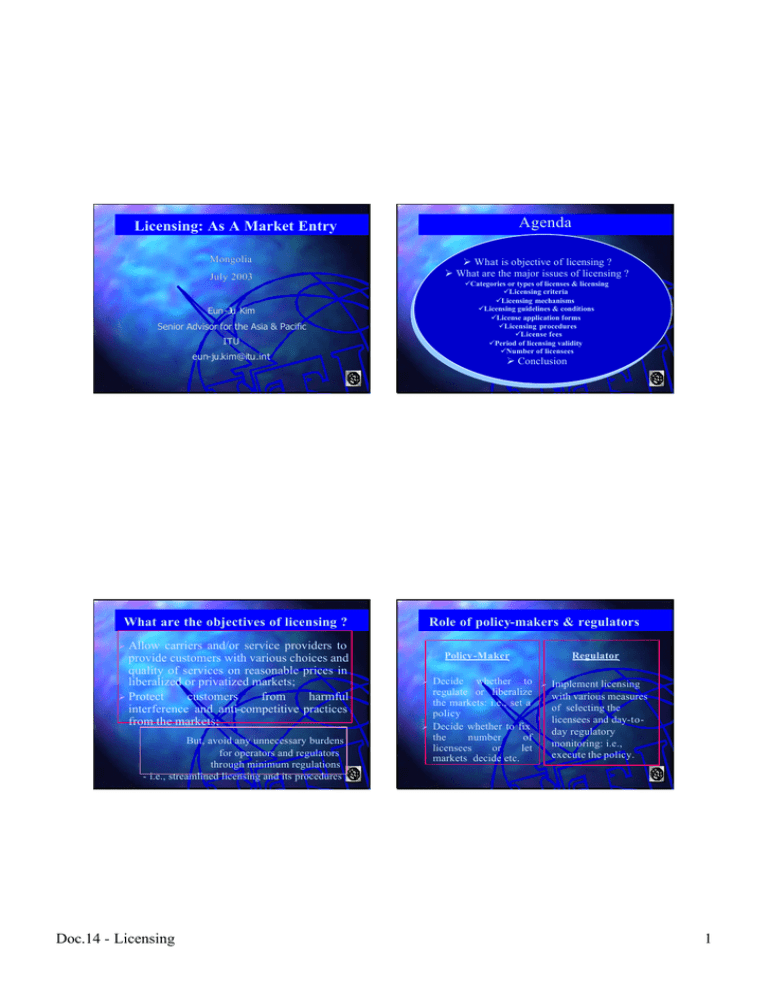
Agenda Licensing: As A Market Entry Mongolia Ø Ø What What isis objective objective of of licensing licensing ?? Ø Ø What What are are the the major major issues issues of of licensing licensing ?? July 2003 üCategories üCategoriesor ortypes typesof oflicenses licenses& &licensing licensing üLicensing üLicensingcriteria criteria üLicensing üLicensing mechanisms mechanisms üLicensing üLicensingguidelines guidelines& &conditions conditions üLicense üLicenseapplication applicationforms forms üLicensing procedures üLicensing procedures üLicense üLicensefees fees üPeriod üPeriodof oflicensing licensingvalidity validity üNumber üNumberof oflicensees licensees Eun-- Ju Kim Eun Senior Advisor for the Asia & Pacific ITU eun-- ju eun ju..kim kim@ @itu itu..int Ø Ø Conclusion Conclusion What are the objectives of licensing ? Role of policypolicy-makers & regulators Ø Allow carriers and/or service providers to provide customers with various choices and quality of services on reasonable prices in liberalized or privatized markets; Ø Protect customers from harmful interference and anti-competitive practices from the markets; But, avoid any unnecessary burdens for operators and regulators through minimum regulations - i.e., streamlined licensing and its procedures Doc.14 - Licensing Policy-Maker Ø Ø Decide whether to regulate or liberalize the markets: i.e., set a policy Decide whether to fix the number of licensees or let markets decide etc. Regulator Ø Implement licensing with various measures of selecting the licensees and day-today regulatory monitoring: i.e., execute the policy. 1 What are the major issues of licensing ? ü ü ü ü ü ü ü ü ü Categories or types of licenses & licensing Licensing criteria Licensing mechanisms Licensing guidelines & conditions License applications Licensing procedures License fees Period of licensing validity Number of licensees etc…. Licensing categories or types (2) Malaysia: Licensing Migration map onto New technology-neutral and service -neutral licenses VAN license Content Services ISP license Telecommunication license Broadcasting license The old licenses that were issued based on specific technologies, and specific services Applications Services Network Services Network Facilities Licensing categories or types (1) EXAMPLES Hong Kong Ø Ø Exclusive license Carrier license – fixed – mobile – space station Ø Ø Class license Others India Ø Ø Ø Ø Ø Ø Basic service license Cellular mobile license Radio paging license Internet Value-- added service Value license GMPCS etc. Licensing categories or types (3) Malaysia Ø Individual Licenses • Content applications service provider • Applications service provider • Network service provider • Network facilities provider Ø Class Licenses (Current) • Applications service provider * One SP can have multiple licenses R.O.Korea Ø Facility- based (34): e.g., • Local (2) • Long-Distance (3) • International (3) • Leased line (14) • Cellular, PCS, GMPCS • TRS, Paging, Wireless Data, • B-WLL, IMT-2000 Ø Non-facility -based (3191) • Special (314) • Value-added (2,877) (numbers): as of 2002 Doc.14 - Licensing 2 Licensing categories or types (3) Licensing criteria Mongolia Hong Kong Ø “A” Classification Licenses (3) ü Ø ‘B’ Classification Licenses (14) ü ü ü ü ü ü Scale of investment & capacity Financial capability Performance bond Technical soundness & quality of service Proven managerial & technical expertise Implementation schedule Quality of proposal etc. Licensing mechanism 1. 2. 3. 4. 5. 6. 7. Case-by-case ad-hoc decision- making on a firstcome first-served principle; Comparative & qualitative evaluation of bid (i.e., a ‘beauty content’) among short-listed bidder; Comparative hearings; Lottery; Auction; Combination of the above (e.g., an auction among bidders who succeed in the initial beauty contest); Simple register etc….. India ü ü ü ü ü Licensee should be Indian co. Foreign equity should not exceed 49%. Execution of performance bank guarantee Stipulated network & experience Comply with technical specification, commercial & financial conditions etc. Licensing guidelines & condition (1) The guidelines & conditions differ in each license. Example: Hong Kong for FTNS Ø External Fixed Telecom Network Service: üIntroduction of the scope üRegulatory framework üTerms of licensing arrangement üRelevant information for applicants re their proposals or applications etc. Depending on types of licenses in the country Doc.14 - Licensing 3 Licensing guidelines & condition (2) Licensing guidelines & condition (3) Example: Malaysia for class license Example: Malaysia for individual license ü Corporate ü – – – – ü Operations Incorporation Share holding, JV Sole license for activity Compliance with CMA – Numbering plan, electronic addressing, spectrum plan – Consumer code – Rates – Safety measures – Charge mechanism – License fees Indemnity Change in license condition ü ü ü ü ü Special licensing condition (4) 1. Obligation to provide Universal Service And/Or To Contribute To USF - The licensee shall comply with any determination made on USO. CONTRIBUTION TO USO FUND:: FUND All licensees except Content Application Service Provider (CASP) Licensees whose annual total revenue derived from designated services exceeds –e.g.RM500,000 Contribution is determined at 6% of the total weighted net revenue from designated services Doc.14 - Licensing Example: Malaysia – Notify the Minister of any restructuring or rationalization of the individual’’s corporate individual structure Additional for CASP(I) [Reg. 22(2)] 3. – – Provide local content programmes and those that promote national culture and identity Carry public announcements for the purposes of the government or for public or national interest. ü ü ü ü ü Safety measures Charging mechanism Indemnity Fees Change of particulars of the registration notice Special licensing condition (5) Example: Korea For all individual licensees [Reg. 18] 2. Permitted activities Sole license Compliance with the law Compliance with the numbering plan, the electronic addressing plan, and Consumer Codes Ø Ø Contribute to research and development (R&D)) determined at certain percentage of the (R&D total revenue from licensees; and/or Contribute to the development of national informatization funds determined at certain percentage of the total revenue from licensees etc. 4 License applications: CheckCheck -list India Hong Kong Licensing procedures 1. 2. ü ü ü ü ü ü Company structure & financial capability Description of service Technical details of the system Technical support Experience of applicant Compliance with the ITU standards etc. ü ü ü ü Company registration certificate Net worth & experience Annual reports for the last 5 financial years A comprehensive detailed documents etc. 3. 4. 5. 6. Draft by the regulator or government Consultations among various interested parties and experts Prepare for the Guidance Note Invite interested applicants for their proposal or applicant Evaluate the proposals or applicants Grant the relevant license either by ministry or regulator License fees (2) License fees (1) Ø Ø Ø There can be three scopes of licensing fees: – cost cost--recovery – costs of scare resources consumed by operators – sharing values of businesses License fees are in principle recommended to cover the administrative costs, except for the optimal use of scarce resources and/or the special conditions such as USOF, R&D, development national ICT etc. subject to each country ’s circumstances. License and its fees should not be burden (e.g., 3G license) but, in both principle & practice, to the introduction and development of innovative services and competition. Doc.14 - Licensing Application fee RM10,000 Processing fee RM50,000 Annual license fee 0.50% or 0.15% of Gross Annual Turnover (minimum RM50,000) RM25,000 Renewal fee Registration fee Annual registration RM2,500 RM2,500 CLASS LICENSEES INDIVIDUAL LICENSEES Tenure 5 or 10 years Example: Malaysia 5 Period of licensing validity Hong Kong ü ü Number of licensees India Carrier licenses are valid for 15 years with a renewal of further period not exceeding 15 years, Taking into account the life span of technologies, services or systems etc. ü ü Most licenses are valid for 20 years extendible by 10 years at one time, Taking into account the investment required and a reasonable return for the investment. India Hong Kong Ø Ø The number of licensees are in principle determined by markets unless there are physical constraints like spectrum Ø Ø Licences are granted to all applicants when satisfying the entry qualification except wireless communications due to spectrum constraints. Conclusion v Licensing can be a critical means of not only market entries in liberalized markets but also developing ICT infrastructure & its applications, ü When it is implemented in a nonnon-discriminatory, proportionate, fair and transparent manner, and ü When it is mobilized not as a burden for entrants but as a carrot for their innovation and competition. Doc.14 - Licensing For more information please contact: Dr. EunEun-Ju Kim Senior Advisor for Asia & the Pacific, ITU at euneun-ju.kim@itu.int 6
